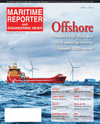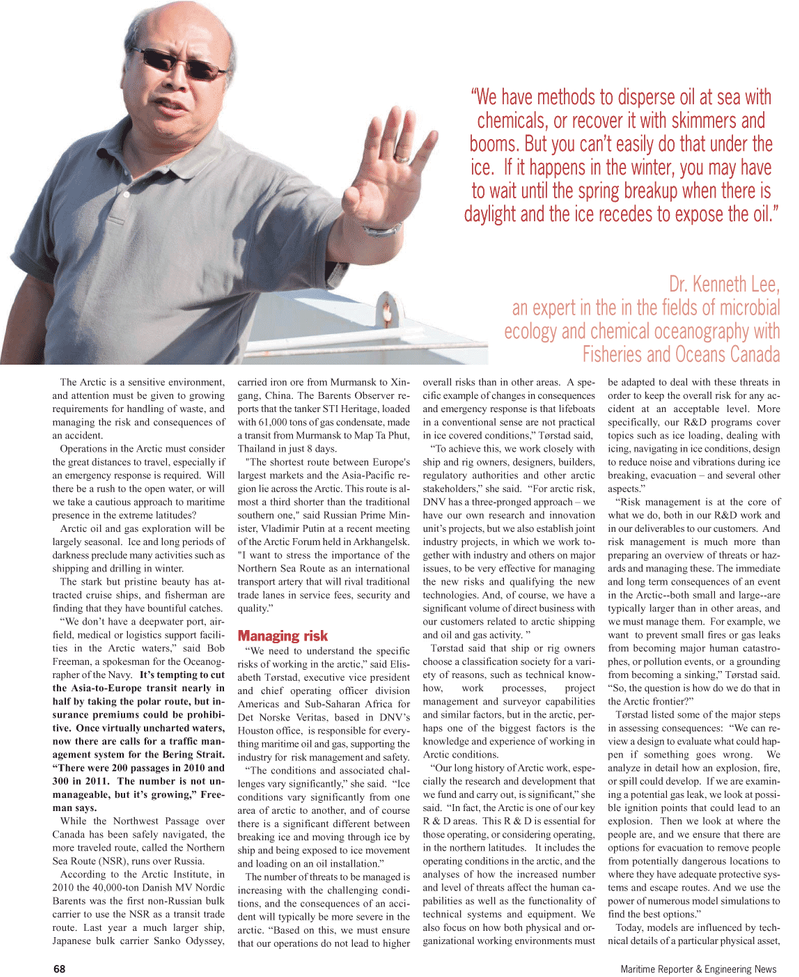
Page 72: of Maritime Reporter Magazine (April 2012)
Offshore Deepwater Annual
Read this page in Pdf, Flash or Html5 edition of April 2012 Maritime Reporter Magazine
68Maritime Reporter & Engineering News The Arctic is a sensitive environment, and attention must be given to growing requirements for handling of waste, and managing the risk and consequences ofan accident.Operations in the Arctic must consider the great distances to travel, especially if an emergency response is required. Will there be a rush to the open water, or will we take a cautious approach to maritime presence in the extreme latitudes? Arctic oil and gas exploration will be largely seasonal. Ice and long periods of darkness preclude many activities such as shipping and drilling in winter. The stark but pristine beauty has at- tracted cruise ships, and fisherman are finding that they have bountiful catches. We dont have a deepwater port, air- field, medical or logistics support facili- ties in the Arctic waters,? said Bob Freeman, a spokesman for the Oceanog- rapher of the Navy. Its tempting to cut the Asia-to-Europe transit nearly in half by taking the polar route, but in- surance premiums could be prohibi- tive. Once virtually uncharted waters, now there are calls for a traffic man- agement system for the Bering Strait. There were 200 passages in 2010 and 300 in 2011. The number is not un- manageable, but its growing,? Free- man says.While the Northwest Passage over Canada has been safely navigated, the more traveled route, called the Northern Sea Route (NSR), runs over Russia. According to the Arctic Institute, in 2010 the 40,000-ton Danish MV NordicBarents was the first non-Russian bulk carrier to use the NSR as a transit traderoute. Last year a much larger ship, Japanese bulk carrier Sanko Odyssey, carried iron ore from Murmansk to Xin-gang, China. The Barents Observer re- ports that the tanker STI Heritage, loaded with 61,000 tons of gas condensate, made a transit from Murmansk to Map Ta Phut, Thailand in just 8 days."The shortest route between Europe'slargest markets and the Asia-Pacific re- gion lie across the Arctic. This route is al- most a third shorter than the traditionalsouthern one," said Russian Prime Min-ister, Vladimir Putin at a recent meeting of the Arctic Forum held in Arkhangelsk. "I want to stress the importance of the Northern Sea Route as an internationaltransport artery that will rival traditional trade lanes in service fees, security andquality.? Managing riskWe need to understand the specific risks of working in the arctic,? said Elis- abeth Tørstad, executive vice president and chief operating officer division Americas and Sub-Saharan Africa for Det Norske Veritas, based in DNVs Houston office, is responsible for every- thing maritime oil and gas, supporting the industry for risk management and safety. The conditions and associated chal-lenges vary significantly,? she said. Ice conditions vary significantly from one area of arctic to another, and of course there is a significant different between breaking ice and moving through ice by ship and being exposed to ice movement and loading on an oil installation.? The number of threats to be managed isincreasing with the challenging condi-tions, and the consequences of an acci-dent will typically be more severe in the arctic. Based on this, we must ensurethat our operations do not lead to higheroverall risks than in other areas. A spe- cific example of changes in consequences and emergency response is that lifeboats in a conventional sense are not practical in ice covered conditions,? Tørstad said, To achieve this, we work closely with ship and rig owners, designers, builders, regulatory authorities and other arctic stakeholders,? she said. For arctic risk, DNV has a three-pronged approach ? wehave our own research and innovation units projects, but we also establish joint industry projects, in which we work to- gether with industry and others on majorissues, to be very effective for managing the new risks and qualifying the new technologies. And, of course, we have a significant volume of direct business with our customers related to arctic shippingand oil and gas activity. ? Tørstad said that ship or rig owners choose a classification society for a vari- ety of reasons, such as technical know- how, work processes, project management and surveyor capabilities and similar factors, but in the arctic, per- haps one of the biggest factors is the knowledge and experience of working in Arctic conditions. Our long history of Arctic work, espe- cially the research and development that we fund and carry out, is significant,? she said. In fact, the Arctic is one of our key R & D areas. This R & D is essential for those operating, or considering operating,in the northern latitudes. It includes theoperating conditions in the arctic, and theanalyses of how the increased number and level of threats affect the human ca- pabilities as well as the functionality oftechnical systems and equipment. We also focus on how both physical and or- ganizational working environments must be adapted to deal with these threats inorder to keep the overall risk for any ac- cident at an acceptable level. More specifically, our R&D programs cover topics such as ice loading, dealing withicing, navigating in ice conditions, design to reduce noise and vibrations during icebreaking, evacuation ? and several other aspects.? Risk management is at the core ofwhat we do, both in our R&D work and in our deliverables to our customers. And risk management is much more thanpreparing an overview of threats or haz- ards and managing these. The immediate and long term consequences of an event in the Arctic--both small and large--are typically larger than in other areas, and we must manage them. For example, we want to prevent small fires or gas leaks from becoming major human catastro-phes, or pollution events, or a grounding from becoming a sinking,? Tørstad said. So, the question is how do we do that in the Arctic frontier?? Tørstad listed some of the major stepsin assessing consequences: We can re- view a design to evaluate what could hap- pen if something goes wrong. We analyze in detail how an explosion, fire, or spill could develop. If we are examin- ing a potential gas leak, we look at possi- ble ignition points that could lead to anexplosion. Then we look at where the people are, and we ensure that there areoptions for evacuation to remove people from potentially dangerous locations towhere they have adequate protective sys- tems and escape routes. And we use the power of numerous model simulations to find the best options.? Today, models are influenced by tech- nical details of a particular physical asset, We have methods to disperse oil at sea with chemicals, or recover it with skimmers and booms. But you cant easily do that under theice. If it happens in the winter, you may have to wait until the spring breakup when there is daylight and the ice recedes to expose the oil.? Dr. Kenneth Lee, an expert in the in the fields of microbial ecology and chemical oceanography with Fisheries and Oceans Canada

 71
71

 73
73
